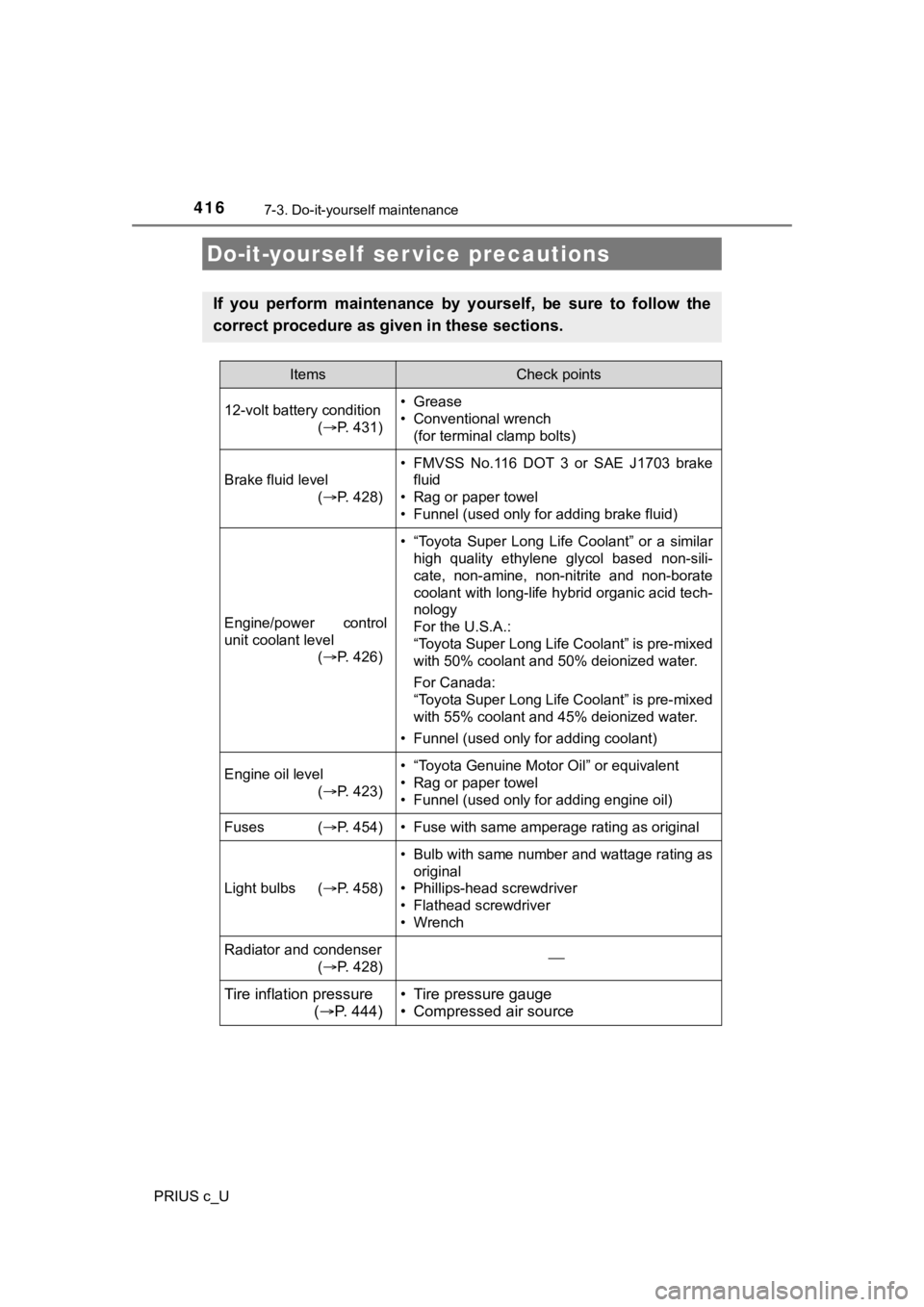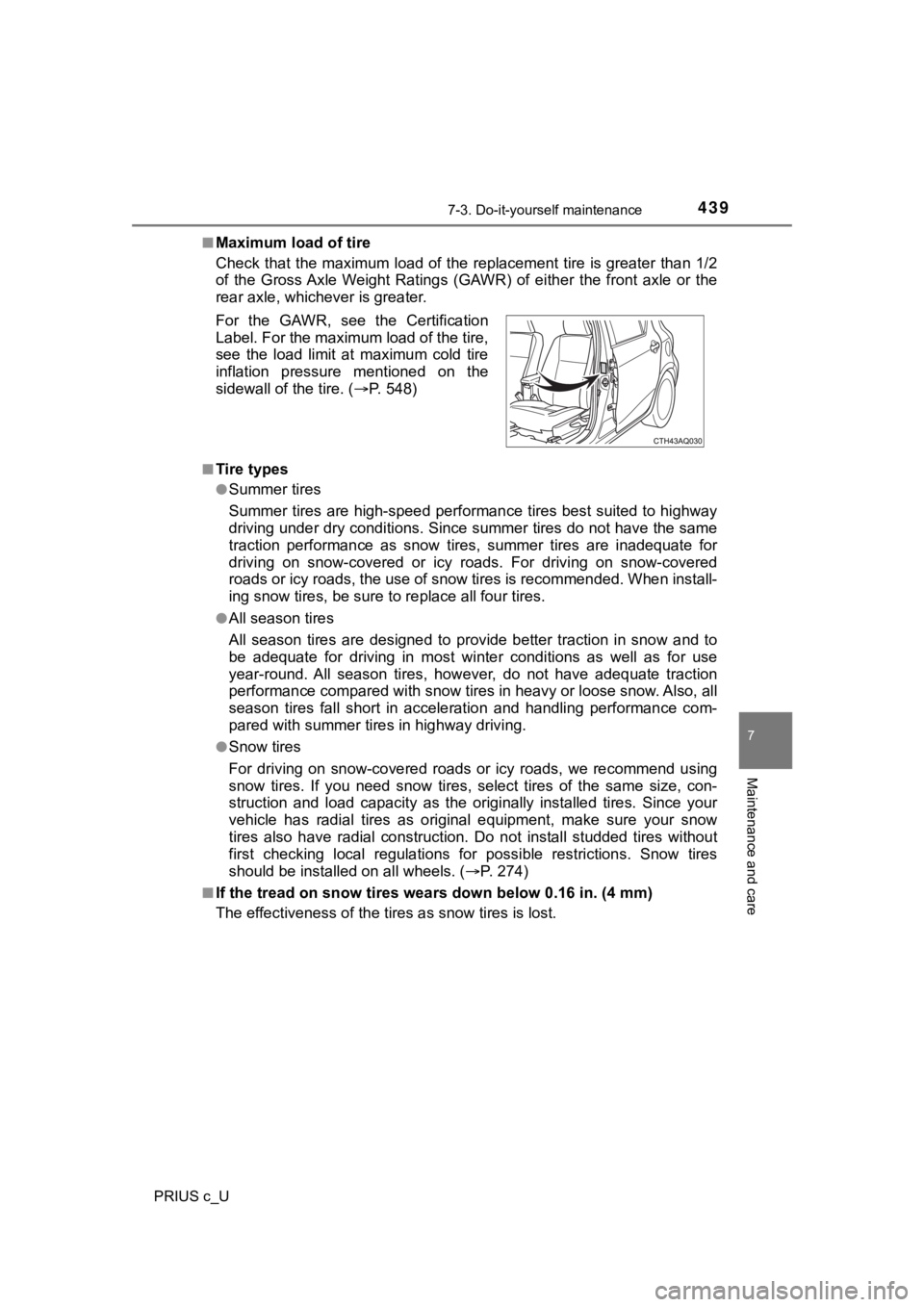inflation pressure TOYOTA PRIUS C 2020 Owners Manual
[x] Cancel search | Manufacturer: TOYOTA, Model Year: 2020, Model line: PRIUS C, Model: TOYOTA PRIUS C 2020Pages: 600, PDF Size: 12.02 MB
Page 6 of 600

TABLE OF CONTENTS6
PRIUS c_U7-1. Maintenance and care
Cleaning and protecting the vehicle exterior .......... 400
Cleaning and protecting the vehicle interior ........... 403
7-2. Maintenance Maintenance requirements ................... 409
General maintenance ........ 412
Emission inspection and maintenance (I/M)
programs ......................... 415
7-3. Do-it-yourself maintenance
Do-it-yourself service precautions ..................... 416
Hood.................................. 419
Positioning a floor jack ...... 421
Engine compartment ......... 422
12-volt battery ................... 431
Tires .................................. 435
Tire inflation pressure........ 444
Wheels .............................. 447
Air conditioning filter .......... 449
Wireless remote control/ electronic key battery ...... 451
Checking and replacing fuses ................ 454
Light bulbs ......................... 458 8-1. Essential information
Emergency flashers ........... 468
If your vehicle has to be stopped in
an emergency.................. 469
If the vehicle is trapped in rising water .................. 471
8-2. Steps to take in an emergency
If your vehicle needs to be towed ...................... 472
If you think something is wrong ........................... 479
If a warning light turns on or a warning buzzer
sounds ............................. 480
If a warning message is displayed...................... 488
If you have a flat tire .......... 505
If the hybrid system will not start ..................... 518
If the electronic key does not operate properly .......... 520
If the vehicle 12-volt
battery is discharged ....... 522
If your vehicle overheats.... 529
If the vehicle becomes stuck ................ 533
7Maintenance and care8When trouble arises
Page 17 of 600

17Pictorial index
PRIUS c_UWindshield wipers . . . . . . . . . . . . . . . . . . . . . . . . . . . . . . . . . P. 214
Precautions against winter season . . . . . . . . . . . . . . . . . . . . . P. 274
Fuel filler door . . . . . . . . . . . . . . . . . . . . . . . . . . . . . . . . . . . . P. 221
Refueling method . . . . . . . . . . . . . . . . . . . . . . . . . . . . . . . . . . . P. 221
Fuel type/fuel tank capacity . . . . . . . . . . . . . . . . . . . . . . . . . . . P. 538
Tires . . . . . . . . . . . . . . . . . . . . . . . . . . . . .
. . . . . . . . . . . . . P. 435
Tire size/inflation pressure . . . . . . . . . . . . . . . . . . . . . . . . . P. 543
Winter tires/tire chain . . . . . . . . . . . . . . . . . . . . . . . . . . . . . P. 274
Checking/rotation/tire pressur e warning system . . . . . . . . .P. 435
Coping with flat tires . . . . . . . . . . . . . . . . . . . . . . . . . . . . . . P. 505
Hood . . . . . . . . . . . . . . . . . . . . . . . . . . . . . . . . . . . . . . . . . . . . P. 419
Opening . . . . . . . . . . . . . . . . . . . . . . . . . . . . . . . . . . . . . . . . . . P. 419
Engine oil . . . . . . . . . . . . . . . . . . . . . . . . . . . . . . . . . . . . . . . . . P. 539
Coping with overheat . . . . . . . . . . . . . . . . . . . . . . . . . . . . . . . . P. 529
Headlights/daytime running lights . . . . . . . . . . . . . . . . . . . . P. 208
Parking lights/front turn signal lights . . . . . . . . . . . . . P. 206, 208
Side turn signal lights . . . . . . . . . . . . . . . . . . . . . . . . . . . . . . P. 206
Front fog lights
*. . . . . . . . . . . . . . . . . . . . . . . . . . . . . . . . . . . P. 212
Front side marker lights . . . . . . . . . . . . . . . . . . . . . . . . . . . . P. 208
Stop lights/tail lights /rear side marker lights/
rear turn signal lights . . . . . . . . . . . . . . . . . . . . . . . . . . P. 206, 208
Back-up lights
Shifting the shift lever to R . . . . . . . . . . . . . . . . . . . . . . . . . . . . P. 202
License plate lights . . . . . . . . . . . . . . . . . . . . . . . . . . . . . . . . P. 208
4
5
6
7
Light bulbs of the exterior lights for driving
(Replacing method: P. 458, Watts: P. 544)
*: If equipped
8
9
10
11
12
13
14
15
Page 240 of 600

2404-5. Toyota Safety Sense C
PRIUS c_U• If the wheels are misaligned
• If a wiper blade is blocking the camera sensor
• The vehicle is being driven at extremely high speeds
• When driving on a hill
• When there is a laser reflecting object (manhole cover, reflec
tive plate,
etc.), steps, or a protrusion in front of your vehicle
• If the radar sensor or camera sensor is misaligned
● In some situations such as the following, sufficient braking fo rce may not be
obtained, preventing the system from performing properly:
• If the braking functions cannot operate to their full extent, such as when
the brake parts are extremely cold, extremely hot, or wet
• If the vehicle is not properly maintained (brakes or tires are excessively
worn, improper tire inflation pressure, etc.)
• When the vehicle is being driven on a gravel road or other sli ppery sur-
face
■ If VSC is disabled
●If VSC is disabled ( P. 267), the pre-collision brake assist and pre-collision
braking functions are also disabled.
● The PCS warning light will turn on and “VSC TURNED OFF PRE-COLL I-
SION BRAKE SYSTEM UNAVAILABLE” will be displayed on the multi-i nfor-
mation display. • If the front of the vehicle is raised or
lowered
Page 270 of 600

2704-6. Using the driving support systems
PRIUS c_U
WARNING
■Replacing tires
Make sure that all tires are of the specified size, brand, trea d pattern and
total load capacity. In addition, make sure that the tires are inflated to the
recommended tire inflation pressure level.
The ABS, TRAC and VSC systems will not function correctly if di fferent tires
are installed on the vehicle.
Contact your Toyota dealer for further information when replaci ng tires or
wheels.
■ Handling of tires and the suspension
Using tires with any kind of problem or modifying the suspensio n will affect
the driving assist systems, and may cause a system to malfuncti on.
Page 272 of 600

2724-7. Driving tips
PRIUS c_U
◆Delays
Repeated acceleration and deceleration, as well as long waits at
traffic lights, will lead to bad fuel economy. Check traffic re ports
before leaving and avoid delays as much as possible. When drivi ng
in a traffic jam, gently release the brake pedal to allow the v ehicle to
move forward slightly while avoiding overuse of the accelerator
pedal. Doing so can help control excessive gasoline consumption.
◆Highway driving
Control and maintain the vehicle at a constant speed. Before st op-
ping at a toll booth or similar, allow plenty of time to releas e the
accelerator and gently apply the brakes. A greater amount of el ec-
trical energy can be regenerated when slowing down.
◆Air conditioning
Use the air conditioning only when necessary. Doing so can help
reduce excessive gasoline consumption.
In summer: When the ambient tempe rature is high, use the recircu-
lated air mode. Doing so will help to reduce the burden on the air
conditioning system and reduce fuel consumption as well.
In winter: Because the gasolin e engine will not automatically cut out
until it and the interior of the vehicle are warm, it will cons ume fuel.
Also, fuel consumption can be improved by avoiding overuse of t he
heater.
◆Checking tire inflation pressure
Make sure to check the tire inflation pressure frequently. Impr oper
tire inflation pressure can cause poor fuel economy.
Also, as snow tires can cause large amounts of friction, their use on
dry roads can lead to poor fuel economy. Use tires that are app ro-
priate for the season.
◆Luggage
Carrying heavy luggage will lead to poor fuel economy. Avoid carry-
ing unnecessary luggage. Installing a large roof rack will also cause
poor fuel economy.
Page 399 of 600

399
7Maintenance and care
PRIUS c_U7-1. Maintenance and care
Cleaning and protecting the vehicle exterior .......... 400
Cleaning and protecting the vehicle interior ........... 403
7-2. Maintenance Maintenance requirements ................... 409
General maintenance........ 412
Emission inspection and maintenance (I/M)
programs......................... 415
7-3. Do-it-yourself maintenance
Do-it-yourself service precautions ..................... 416
Hood ................................. 419
Positioning a floor jack ...... 421
Engine compartment ......... 422
12-volt battery ................... 431
Tires .................................. 435
Tire inflation pressure ....... 444
Wheels .............................. 447
Air conditioning filter.......... 449
Wireless remote control/ electronic key battery ...... 451
Checking and replacing fuses ................ 454
Light bulbs......................... 458
Page 416 of 600

416
PRIUS c_U
7-3. Do-it-yourself maintenance
Do-it-yourself ser vice precautions
If you perform maintenance by yourself, be sure to follow the
correct procedure as given in these sections.
ItemsCheck points
12-volt battery condition (P. 431) • Grease
• Conventional wrench
(for terminal clamp bolts)
Brake fluid level
(P. 428)
• FMVSS No.116 DOT 3 or SAE J1703 brake
fluid
• Rag or paper towel
• Funnel (used only for adding brake fluid)
Engine/power control
unit coolant level (P. 426)
• “Toyota Super Long Life Coolant” or a similar
high quality ethylene glycol based non-sili-
cate, non-amine, non-nitrite and non-borate
coolant with long-life hybrid organic acid tech-
nology
For the U.S.A.:
“Toyota Super Long Life Coolant” is pre-mixed
with 50% coolant and 50% deionized water.
For Canada:
“Toyota Super Long Life Coolant” is pre-mixed
with 55% coolant and 45% deionized water.
• Funnel (used only for adding coolant)
Engine oil level (P. 423)• “Toyota Genuine Motor Oil” or equivalent
• Rag or paper towel
• Funnel (used only for adding engine oil)
Fuses ( P. 454)• Fuse with same amperage rating as original
Light bulbs (P. 458)
• Bulb with same number and wattage rating as
original
• Phillips-head screwdriver
• Flathead screwdriver
• Wrench
Radiator and condenser
(P. 428)
Tire inflation pressure
( P. 444)• Tire pressure gauge
• Compressed air source
Page 436 of 600

4367-3. Do-it-yourself maintenance
PRIUS c_U
Your vehicle is equipped with a tire pressure warning system that uses
tire pressure warning valves and transmitters to detect low tire infla-
tion pressure before serious problems arise.
If the tire pressure drops below a predetermined level, the dri ver is
warned by a warning light. ( P. 483)
◆Installing tire pressure warn ing valves and transmitters
When replacing tires or wheels, tire pressure warning valves an d
transmitters must also be installed.
When new tire pressure warning valves and transmitters are
installed, new ID codes must be registered in the tire pressure
warning computer and the tire pressure warning system must be
initialized. Have tire pressure warning valve and transmitter I D
codes registered by your Toyota dealer. ( P. 437)
◆Initializing the tire pressure warning system
■The tire pressure warning system must be initialized in the fol-
lowing circumstances:
● When rotating front and rear tires which have different tire in fla-
tion pressures
● When changing the tire size
When the tire pressure warning sy stem is initialized, the current tire
inflation pressure is set as the benchmark pressure.
■How to initialize the tire pressure warning system
Park the vehicle in a safe place and turn the power switch (vehi-
cles without a smart key system) or the power switch (vehicles
with a smart key system) off.
Initialization cannot be perfo rmed while the vehicle is moving.
Adjust the tire inflation pressure to the specified cold tire i nflation
pressure level. ( P. 543)
Make sure to adjust the tire pre ssure to the specified cold tire infla-
tion pressure level. The tire pressure warning system will oper ate
based on this pr essure level.
Tire pressure warning system
1
2
Page 438 of 600

4387-3. Do-it-yourself maintenance
PRIUS c_U
■When to replace your vehicle's tires
Tires should be replaced if:
●The treadwear indicators are showing on a tire.
●You have tire damage such as cuts, splits, cracks deep enough t o
expose the fabric, and bulges indicating internal damage
●A tire goes flat repeatedly or c annot be properly repaired due to the size
or location of a cut or other damage
If you are not sure, consult with your Toyota dealer.
■Replacing tires and wheels
If the ID code of the tire press ure warning valve and transmitt er is not reg-
istered, the tire pressure warni ng system will not work properly. A f t e r d r i v -
ing for about 20 minutes, the tire pressure warning light blink s for 1
minute and stays on to indi cate a system malfunction.
■Tire life
Any tire over 6 years old must be checked by a qualified techni cian even
if it has seldom or never been u sed or damage is not obvious.
■Routine tire inflation pressure checks
The tire pressure warning system does not replace routine tire inflation
pressure checks. Make sure to chec k tire inflation pressure as part of
your routine of daily vehicle checks.
■Low profile tires (vehicles with P195/50R16 tires)
Generally, low profile tires will wear more rapidly and tire gr ip perfor-
mance will be reduced on snowy and /or icy roads when compared to
standard tires. Be sure to use snow tires or tire chains on sno wy and/or
icy roads and drive carefully at a speed appropriate for road a nd weather
conditions.
Page 439 of 600

4397-3. Do-it-yourself maintenance
7
Maintenance and care
PRIUS c_U■
Maximum load of tire
Check that the maximum load of t
he replacement tire is greater than 1/2
of the Gross Axle Weight Ratings (GAWR) of either the front axl e or the
rear axle, whichever is greater.
■Tire types
●Summer tires
Summer tires are high-speed performance tires best suited to hi ghway
driving under dry conditions. Si nce summer tires do not have th e same
traction performance as snow tires, summer tires are inadequate for
driving on snow-covered or icy ro ads. For driving on snow-covered
roads or icy roads, the use of snow tires is recommended. When install-
ing snow tires, be sure to replace all four tires.
●All season tires
All season tires are designed to provide better traction in sno w and to
be adequate for driving in most winter conditions as well as fo r use
year-round. All season tires, however, do not have adequate tra ction
performance compared with snow tires in heavy or loose snow. Al so, all
season tires fall short in acceleration and handling performanc e com-
pared with summer tires in highway driving.
●Snow tires
For driving on snow-covered roads or icy roads, we recommend us ing
snow tires. If you need snow tires, select tires of the same si ze, con-
struction and load capacity as t he originally installed tires. Since your
vehicle has radial tires as original equipment, make sure your snow
tires also have radial construct ion. Do not install studded tires without
first checking local regulations for possible restrictions. Sno w tires
should be install ed on all wheels. ( P. 274)
■If the tread on snow tires wea rs down below 0.16 in. (4 mm)
The effectiveness of the tires as snow tires is lost. For the GAWR, see the Certification
Label. For the maximum load of the tire,
see the load limit at maximum cold tire
inflation pressure mentioned on the
sidewall of the tire. ( P. 5 4 8 )